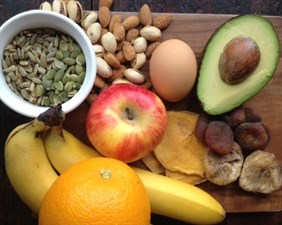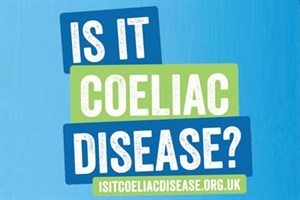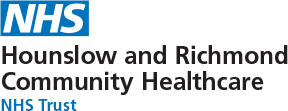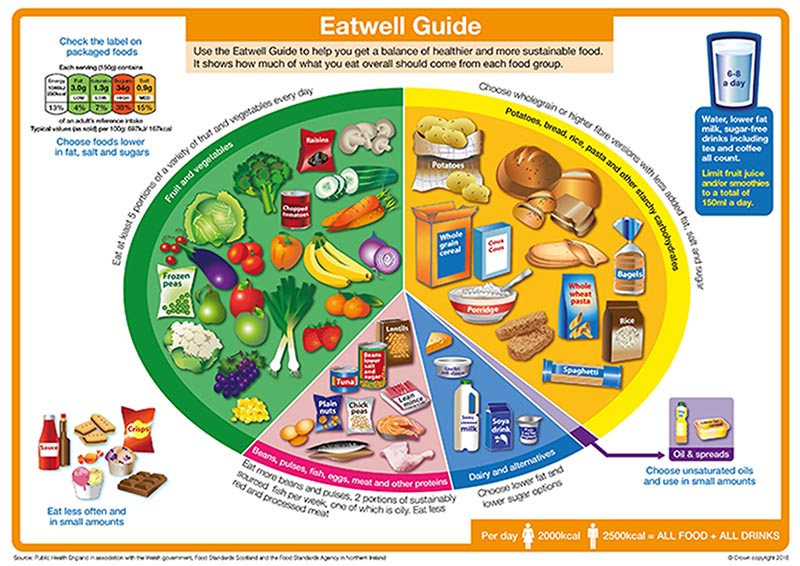If you’re stuck for healthy eating ideas - or need some help getting started, our dietitians can help!
Check out our specialist dietitians' various healthy recipe ideas and advice on how to achieve a balanced, nutritious diet - along with information about eating well if you have a dietary condition.
Sticking to healthy eating habits is not as hard as many people think. The essential steps are to eat mostly foods derived from plants - including vegetables, fruits, whole grains and legumes (beans, peas, lentils) - and to limit highly processed foods.

It can be hard to eat healthy at work - particularly when there is a constant supply of chocolate and biscuits. They are in your office, looking at you and almost screaming “eat me, I taste so good!”
“But what else can I have?”, you may ask. Well, there are a variety a delicious and healthy snacks you can keep on your desk, or in the fridge – the good stuff. Just reach for them when you are peckish and your body will thank you for that.
-
Fruit. This is an obvious one, of course. Fresh or dried are all good. Just be mindful about the sugar content in the dried fruit.
-
Nuts. They have fat but it is a good type of unsaturated fat; something that your body needs. So do not be afraid to have a small handful as a healthy snack option.
-
Yogurt. A good source of calcium and protein. Yogurt can be high in sugar. Go for plain Greek-style natural yogurt, reduced sugar options and one with probiotics.
-
Crispbread. Particularly the one with seeds on it is an excellent source of fibre and B vitamins.
-
Rice cakes. A good choice if you are trying to lose weight because they are low in calories and frankly speaking how many can you eat in one go? Not that many.
-
Dark chocolate. Finally! Chocolate! Yes, it is chocolate but a more bitter version because it has a higher coco content and less sugar. You can choose plain one or the one with coconut, ginger, orange bits or whatever you may desire. A few squares of dark chocolate is plenty.
So here you go. A list of healthy snacks for you to have . Start tomorrow, you will be glad you did. No more excuses to reach for that biscuit or cake, unless it is a special occasion, of course.
Normunds Barons, RD, BSc
Community Dietitian

Gluten has become a dirty word amongst many celebrities, self – styled nutrition gurus and the ever growing clean eating dieters. However, in those with a real intolerance to gluten, eating gluten has a serious health impact.
This week is the National Coeliac Disease awareness week. Coeliac disease is an autoimmune disease causing the immune system to react to gluten. It is known that 1 in a 100 people has coeliac disease.
How do you know if you have coeliac disease?
Symptoms may vary from mild to severe and can include bloating, diarrhoea, nausea, wind, constipation, tiredness, mouth ulcers, hair loss, anaemia, sudden or unexpected weight loss (but not always). However, some people do not experience any symptoms and coeliac may remain undetected. The aforementioned symptoms could also present in other conditions such as irritable bowel syndrome.
As coeliac disease is an autoimmune condition it is therefore linked to other autoimmune conditions such as type 1 diabetes or thyroid disease. Also, if you have a first degree relative with coeliac disease, you have a 10% risk of being coeliac.
Testing for coeliac disease includes a blood test and a gut biopsy. It is important not to remove gluten from your diet while the tests are being carried out to ensure an accurate result. If you have been diagnosed with coeliac disease, you will need to follow a gluten – free diet for life.
Gluten is a protein found in barley, rye and wheat. Eating gluten if you have coeliac disease will damage the lining of the small intestines. This will result in malabsorption of calories, vitamins and minerals. There are lots of unprocessed naturally gluten free foods such as
-
All types of rice, potatoes, corn (maize)
-
Plain meat, poultry, fish, eggs, beans and pulses
-
Fruits and vegetables
-
Cheese, milk and most yoghurts
If you are concerned about coeliac disease, you could find more information at www.coeliac.org.uk. If you suspect that you may have coeliac disease talk to your GP about testing for coeliac disease and asked to be referred to a dietitian.

Bowel Cancer Awareness Month takes place throughout April 2017. Bowel cancer, also known as colorectal cancer affects the large bowel which is made up of the colon and the rectum. Cancer starts when something goes wrong in the cell and it starts growing uncontrollably to form a tumour. Bowel cancer is the fourth most common cancer in the UK after breast, prostate and lung cancers. It is also the UK’s second biggest cancer killer due to late diagnosis.
According to Bowel Cancer UK, 41,200 people are diagnosed with bowel cancer every year in the UK. More than 9 out of 10 people diagnosed with bowel cancer are aged over 50 years old. Your risk of developing bowel cancer also increases if you have a strong family history of bowel cancer or you have a genetic condition or bowel condition such as Crohns and ulcerative colitis.
Screening is a way of testing healthy people for early stages of an illness before they get any symptoms. It aims to detect cancer at an early stage when treatment is more likely to be successful. In England, Wales and Northern Ireland, people over the age of 60 are invited for screening, whilst in Scotland, screening starts at the age of 50.
Symptoms of bowel cancer can include:
- Bleeding from your rectum or blood in your stool
- A persistent change in your bowel habits, lasting 3 weeks or more
- Abdominal pain or lump in your abdomen
- Unexplained weight loss or tiredness
However, all is not lost as over 50% of all bowel cancers could be prevented through lifestyle changes such as:
- Stop smoking
- Take regular exercises (at least 30 minutes, 5 days of the week)
- Maintain a healthy weight
- Eating less red meat and processed meats
- Increase fibre intake by eating wholegrain foods and at least 5 portions of fruits and vegetables daily
- Drinking less alcohol (no more than 14 units a week).The less you drink, the lower the risk
Practical dietary tips to include more fruits, vegetables and grains into your diet and reduce your risk of bowel cancer:
- Choose higher fibre breakfast cereals such as whole oats, shredded wheat or wholewheat cereals
- Choose wholemeal or granary breads over white bread and go for whole grains such as whole wheat pasta, bulgar wheat or brown rice
- Eat potatoes with their skin on such as baked potatoes or boiled new potatoes
- Add pulses like beans, lentils or chickpeas to stews, curries, soups and salads
- Include plenty of vegetables with your meals either as a side dish or added to sauces, stews or curries
- Have fresh fruits or dried fruits for dessert
- Use fruits, vegetables sticks, oatcakes, rye crackers, unsalted nuts, seeds as snacks and use houmous and avocados as dips


The importance of nutrition and hydration
It is that time of year again when we highlight the need to have good nutrition and to stay well hydrated. You may wonder why we focus on nutrition and fluids. It is well documented that over 3 million people in the UK are at risk malnutrition at any one time and the associated cost of malnutrition equates to over £13 billion a year.
The consequence of malnutrition includes:
- Increased risk of infection
- Risk of pressure sores
- Delayed wound healing
- Reduced muscle strength
- Low mood
- Recurrent and longer hospital stay
Some of the best ways to improve nutrition is through:
- Eating little and often
- Fortifying meals by using high calorie foods such as cheese, oil, butter, milk powder and cream
- Having high calorie snacks such as nuts, crisps, avocados, cheese or hummus on toasts or crackers
Less is known about the prevalence of dehydration especially in the elderly.
Poor hydration has a negative impact including:
- Dehydration
- Tiredness and confusion
- Constipation
- Headaches
- Dry mouth, lips and eyes
- Urinary tract infections
To improve your hydration, try the following:
- Aim to drink at least 8 glasses of fluids per day.Any fluids – water, milk, tea, coffee, squash or fruit juice count. Alcohol does not count and will increase dehydration further
- Most fruits and vegetables have high water content, so have them as part of a healthy snack
- Have soup as part of your meal
If you feel you need assistance with improving your nutrition, ask your GP to refer you to a dietitian.

By Veronica Mitchell, Gastroenterology Dietitian
People often ask me if salt is bad for you. By now you know my principle of “there is no bad food, just bad diets”!
Salt, also known as sodium chloride is made up of two parts, sodium and chlorine. Sodium is an essential nutrient, but the body is unable to produce it naturally. It has a role in regulating many bodily functions including the transport of oxygen and nutrients. It also facilitates other functions such as fluid and acid – base balance. Salt is found naturally in many foods like meat and vegetables. It is also used in foods to make it more palatable and as a preservative to extend its shelf life.
The problem is we are consuming too much salt. In fact we don’t need to add salt to our diet because we could derive all the salt our bodies need from natural sources. Too much salt in our diet has a negative effect on our health. It could increase blood pressure and contribute to the risk of stroke and heart disease. It has also been implicated in increasing the risk of developing osteoporosis, stomach cancer, obesity and kidney problems.
The current recommended daily salt consumption is no more than 6g, which is about one teaspoon of salt. However, the average daily intake of salt in the UK is about 8.1g, the equivalent of one and a half teaspoon. About 75% of our salt intake comes from added salt mainly from processed meat, ready meals, soups, ready – made sauces, breads, cereals, and snacks such as crisps, biscuits and salted nuts.
There are several strategies you can employ to reduce your salt intake:
- Either add salt at the table after you have tasted your food or add a moderate amount of salt during cooking and remove the salt shaker at the table.
- Gradually reduce the amount of salt and use more black pepper, herbs and spices to make your food more flavoursome. Garlic, ginger, chilli, lime and lemon juice are ideal low calorie flavours you could use instead of salt. Your taste will adapt surprisingly fast!
- Try to reduce the amount of processed foods from ready meals and snacks you are eating. The main foods that are high in salt include salted meats such as bacon, ham, sausages, pate, salami and smoked or tinned fish such as salmon, tuna or pilchard. Canned foods especially those in brine, packet and instant soups are also high in salt. In addition, stock cubes, gravy powders or granules as well as condiments like soy sauce, ketchup, mayonnaise and pickles also add to your salt consumption.
- Ask in restaurants and takeaways for low salt options or request for salt not to be added.
- If you have to rely on ready – made foods, read the food labels and choose the lower salt options.
Reading food labels could be a bit of a minefield. Previously, salt was either labelled as such or as sodium. From December 2014, all food labels will only list salt. This would make it easier to see and compare how much salt is contained in food products. So, how much salt is too much? Below is a practical guideline you can use when reading labels and using the traffic light system of labelling:
- Foods high in salt will have more than 1.5g salt per 100g (RED)
- Foods with moderate amount of salt will have between 0.3g and 1.5g salt per 100g (AMBER)
- Foods that are low in salt will have 0.3g or less per 100g (GREEN)
It is important to remember that we don’t often eat foods that are in 100g packages. So, as a guideline, if you are having ready meals or sandwiches, try to choose those that are less than 1.25g salt per meal. For individual foods such as soups or sauces, aim for 0.75g salt per serving.


Detox diet for the new year
With a new year upon us, are you inspired to embark on a healthier and more active lifestyle? Tempted by all the “detox diets” promising to cleanse and help you lose weight? Do you really need to clear toxic waste from your body and relieve your wallet of your hard earned cash?
With the popularity of celebrity bloggers and nutrition gurus, detoxing or clean eating has recently been the “go to” solution for the health – conscious public. However, the idea that by fasting, cutting out food groups such as dairy or wheat, consuming only fruits & vegetables or taking a range of detox solutions, potions or pills is going to rid your body of toxins and help you lose weight is a total nonsense.
If you wanted to make positive changes to your lifestyle, detoxing is not the answer. Changing a habit of a lifetime is not easy. So, it is useful to have a plan. Start with a SMART goal.
-
Specific – make a couple of specific goals. Saying you want to lose weight is quite vague. Commit to a specific amount of weight you aim to lose such as 5kg or drop to a size 12 dress in 3 months. Make it a goal that defines precisely where you want to be at the end.
-
Measurable – include exact amounts or quantities to make it easy to measure your degree of success such as “I will include 1 fruit and 1 vegetable in every meal.
-
Achievable – make sure that it is possible to attain the goal you have set. Otherwise, you may lose confidence and give up. This could be something simple like “I will drink a glass of water before each meal” or “I will walk 10 minutes after dinner every day”. You could always build up from your initial goal.
-
Realistic – try to be ambitious and make it challenging to increase motivation, but don’t make it overwhelming as it may set you up for failure. Your goal should be set high enough that it is realistically achievable. Instead of saying I will become fully vegetarian. Your goal may be to have 1 or 2 meat free days a week.
-
Time specific – a goal is not very useful unless it has a timeframe. Saying that there is always “tomorrow” is not going to help you achieve your goals. Committing to a date when you want to have achieved your goals will keep you focused, gives you a sense of urgency and accountability. Something like, “I will build up from my 10 minute daily walks to a 5km walk once a week by the end of 3 months”.
Finally, I recently read an interesting study done in the University College, London that said it takes an average of 66 days for health behaviour to become a habit. That means repeating the health goals you have set every day for just over 2 months. So, don’t give up just yet. Make the habit stick and see what happens!
Recipes
The importance of a balanced diet
The Eatwell Guide depicts a healthy, balanced diet, which includes:
- eating at least 5 portions of a variety of fruit and vegetables every day
- basing meals on potatoes, bread, rice, pasta or other starchy carbohydrates, ideally wholegrain
- having some dairy or dairy alternatives (such as soya drinks) choosing lower fat and lower sugar options
- eating some beans, pulses, fish, eggs, meat and other proteins (including 2 portions of fish every week, one of which should be oily)
- choosing unsaturated oils and spreads and consuming in small amounts
- drinking 6 to 8 cups or glasses of fluid a day
If consuming foods and drinks high in fat, salt and sugar then have these less often and in small amounts.



